On this page
Expectations for the Dice Setter
Disclaimer
One of the most hotly debated topics among advantage gamblers is whether or not it is possible to influence the throw of the dice in craps. Personally, I'm still skeptical. I don't rule out the possibility, but I'm not convinced. Most casinos happily allow it. If I ran a casino, I would allow it too, because I think the number of people who can influence the dice (if any) is far outweighed by the number who think they can, but can't. Still some people I respect do believe in it, mainly Stanford Wong, who trained under Golden Touch Craps. My craps appendix 3 outlines evidence I have gathered. That said, everything else in this page is from the hypothetical perspective that the dice can be influenced. The purpose of this page is to quantify the player advantage, according to his skill level, and recommend the best dice settings.
How Dice Control Allegedly Works
Even the strongest believers in dice control will admit that most throws, even of the best shooters, are still random. However, it takes a small percentage only of precise throws to overcome the house edge. What is happening on these successful throws? There are two schools of thought, or types of shooters. Both types of shooters set the dice in a certain way, hoping to keep them on axis, and together in rotation, as if the dice were glued together. Two things can go wrong after the dice leave the shooter's hands, and that is what divides the two types of shooters.
The first type of shooter is what I'll call the "correlation shooter." The correlation shooter does no better than a random shooter at keeping the dice on axis. However, when the dice do stay on axis, the rotations of the two dice are correlated. For a random shooter, if the dice did stay on axis, there would be a 25% chance of their landing with the same faces together, as when the dice were in the shooter's hand. The correlation shooter hopes to increase this probability above 25%, by reducing the probability of the dreaded double-pitch throw. A double-pitch is when both dice stay on axis, but one die rotates 180 degrees more than the other. Likewise, a single-pitch is when both dice stay on axis, but one die rotates 90 degrees more or less than the other. Based on a careful reading of Wong on Dice, for purposes of this page, I assume the correlation shooter shoots randomly, except the probability of zero-pitch throws is a certain percentage higher than expectations, at the cost of an equal reduction in double-pitches. Wong never states this is exactly what happens with correlation shooters; it is my own simplified interpretation. To get specific results from my analysis, I had to put in some specific assumptions.
The second type of shooter is what I'll call the "axis shooter." Not only can the axis shooter keep the dice correlated when they do stay on axis, but he can keep them on axis more than the expected 44.44% of the time of a random shooter.
Stanford Wong writes in 'Wong on Dice' that most careful shooters he observed were not keeping both dice on axis more than the random expectations, but were achieving influence through correlation. Based on my faith in Wong, the following tables are all under the assumption of correlation shooting only.
Dice Settings
There are 84 distinct ways to set the dice. In my analysis for this page, I examined all 84 sets, and noted the best set for each bet. The following sets are the only ones that came up as the best for the bets studied. For practical purposes, the only sets you need to know are Hard Ways set #1 and Sevens set #1. The other sets are either equally as good in some situations, or optimal for bets you shouldn’t be making, because better bets are available.
Dice Settings
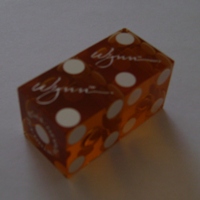 |
Hard Ways Set #1: This is the king of the dice sets. It is the best, or tied for best, for rolling any point before a 7. |
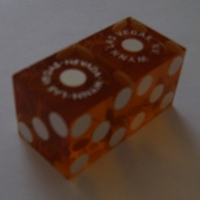 |
Hard Ways Set #2: This set is equally as good as the Hard Ways set #1 for rolling points of 4, 5, 9, and 10. It is also the best set on a come out roll for the don't pass bet. |
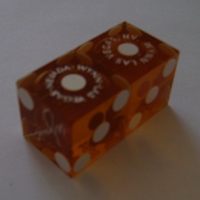 |
Hard Ways Set #3: This set is equally as good as the Hard Ways set #1 for rolling points of 5, 6, 8, and 9. |
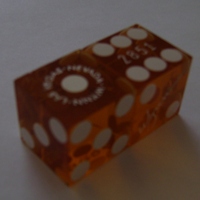 |
Sevens Set #1: In my opinion, this set is the best for rolling sevens. It is the best set on the come out roll for pass line bets. It also tied for best for rolling a seven after a don't pass bet on points of 4, 5, 9, and 10. |
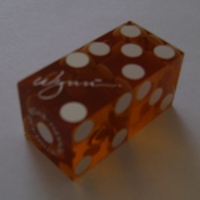 |
Sevens Set #2: This set is the best, or tied for best, for rolling a seven after a don't pass bet on all points. |
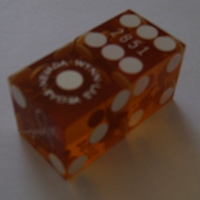 |
Sevens Set #3: This set is the best, or tied for best, for rolling sevens after making a don't pass bet on points of 5, 6, 8, and 9. |
Skill Factor
The skill factor is defined as the percentage of double-pitch throws that the skillful shooter turns into zero-pitch throws. A skill factor of zero would apply to a random shooter, where the probability of both a zero-pitch and double-pitch throw are each (2/3) × (2/3) × (1/4) = 1/9 = 11.11%. A skill factor of 12%, for example, would move 12% of double-pitches into zero-pitches. In this case, the probability of a double-pitch would be 11.11% × 88% = 9.78%, and for a zero-pitch would be 11.11% × 112% = 12.44%. All other outcomes would be the same as that of a random shooter.
Rolls to Sevens Ratio
Most of the time the shooter is going to want to avoid sevens. By far, the most common metric for measuring dice control is the "Sevens:Rolls Ratio," or RSR. As defined in 'Wong on Dice,' the RSR is the ratio of rolls to sevens. I believe that acronym is a misnomer, because the rolls to sevens ratio should be abbreviated RSR. So, I am going to break with convention and call it that. For a random shooter, the probability of a seven is 1/6, so the RSR would be 6. A skillful shooter should be able to throw fewer sevens, and thus increase the RSR above 6. As a basis of comparison to other sources, I will include the RSR in my house edge tables. The RSR's mentioned in 'Wong on Dice' are usually in the range of 6.3 to 7.0.
Pass Line with 3-4-5X Odds
The following table shows the player advantage on the pass line bet, with 3-4-5X odds, according to skill factor. I measured the house edge two different ways. The column for the house edge with the Hard Way set (HW#1), is the house edge if the shooter always uses the Hard Way set #1, even on a come out roll. The column for the house edge with the Hard Way and Seven sets (HW#1 & 7#1) applies when the shooter uses the Seven set #1 on a come out roll, and the Hard Way set #1 otherwise. The reason for listing the house edge for the Hard Way set alone is that many shooters also make come bets, which would lose on a seven on a come out roll. I've observed some so-called skillful shooters using the Hard Way set on a come out roll, even with no come bets. I believe the reason for this is ease in record keeping.
Pass with 3-4-5X Odds
| Skill Factor | RSR | Player Adv. — HW#1 Set | Player Adv. — HW#1 & 7#1 Sets |
|---|---|---|---|
| 0.00 | 6.000 | -0.374% | -0.374% |
| 0.01 | 6.040 | 0.018% | 0.102% |
| 0.02 | 6.081 | 0.414% | 0.581% |
| 0.03 | 6.122 | 0.814% | 1.062% |
| 0.04 | 6.164 | 1.217% | 1.546% |
| 0.05 | 6.207 | 1.623% | 2.032% |
| 0.06 | 6.250 | 2.033% | 2.521% |
| 0.07 | 6.294 | 2.447% | 3.012% |
| 0.08 | 6.338 | 2.864% | 3.506% |
| 0.09 | 6.383 | 3.284% | 4.003% |
| 0.10 | 6.429 | 3.709% | 4.502% |
| 0.11 | 6.475 | 4.137% | 5.004% |
| 0.12 | 6.522 | 4.568% | 5.509% |
| 0.13 | 6.569 | 5.004% | 6.016% |
| 0.14 | 6.618 | 5.443% | 6.527% |
| 0.15 | 6.667 | 5.886% | 7.04% |
| 0.16 | 6.716 | 6.333% | 7.556% |
| 0.17 | 6.767 | 6.784% | 8.074% |
| 0.18 | 6.818 | 7.238% | 8.596% |
| 0.19 | 6.870 | 7.697% | 9.121% |
| 0.20 | 6.923 | 8.160% | 9.648% |
| 0.21 | 6.977 | 8.626% | 10.179% |
| 0.22 | 7.031 | 9.097% | 10.712% |
| 0.23 | 7.087 | 9.572% | 11.249% |
| 0.24 | 7.143 | 10.051% | 11.788% |
| 0.25 | 7.200 | 10.534% | 12.331% |
Don't Pass Line with Laying 3-4-5X Odds
The following table shows the player advantage on the don't pass line bet, with 3-4-5X odds, according to skill factor. As with the pass bet, I measured the house edge two different ways. The first applies if the shooter uses the Seven set #2 on every throw. The second applies if the shooter uses the Hard Way set #2 on the come out roll, and the Seven set #2 on all other throws. Comparing this table to the above table, the player advantage on the pass bet is greater with a skill factor of 0.01 or greater. So, this table is not of much practical value.
Don't Pass, Laying 3-4-5X Odds
| Skill Factor | RSR | Player Adv. — 7#2 Set | Player Adv. — 7#2 & HW#2 Sets |
|---|---|---|---|
| 0.00 | 6.000 | -0.274% | -0.274% |
| 0.01 | 6.040 | 0.021% | 0.080% |
| 0.02 | 6.081 | 0.314% | 0.433% |
| 0.03 | 6.122 | 0.604% | 0.784% |
| 0.04 | 6.164 | 0.892% | 1.133% |
| 0.05 | 6.207 | 1.177% | 1.480% |
| 0.06 | 6.250 | 1.460% | 1.825% |
| 0.07 | 6.294 | 1.741% | 2.168% |
| 0.08 | 6.338 | 2.02% | 2.509% |
| 0.09 | 6.383 | 2.296% | 2.849% |
| 0.10 | 6.429 | 2.570% | 3.186% |
| 0.11 | 6.475 | 2.841% | 3.522% |
| 0.12 | 6.522 | 3.111% | 3.856% |
| 0.13 | 6.569 | 3.378% | 4.189% |
| 0.14 | 6.618 | 3.643% | 4.519% |
| 0.15 | 6.667 | 3.906% | 4.848% |
| 0.16 | 6.716 | 4.166% | 5.175% |
| 0.17 | 6.767 | 4.425% | 5.501% |
| 0.18 | 6.818 | 4.681% | 5.824% |
| 0.19 | 6.870 | 4.935% | 6.146% |
| 0.20 | 6.923 | 5.187% | 6.467% |
| 0.21 | 6.977 | 5.437% | 6.786% |
| 0.22 | 7.031 | 5.685% | 7.103% |
| 0.23 | 7.087 | 5.931% | 7.418% |
| 0.24 | 7.143 | 6.175% | 7.732% |
| 0.25 | 7.200 | 6.417% | 8.045% |
Place and Buy Bets
The next table shows the house edge for placing the 5, 6, 8, and 9, and buying the 4 and 10. When buying the 4 and 10, it is under the rule of paying the commission always. As the table shows, the greatest advantages are on the 6 and 8. If the shooter always used the Hard Way set #1 on the pass line, and had a skill factor of 0.17 or greater, then his advantage would be greater placing the 6 and 8 than the pass line bet with 3-4-5X odds.
Place and Buy Bets
| Skill Factor | RSR | Buy 4,10 | Place 5,9 | Place 6,8 |
|---|---|---|---|---|
| 0.00 | 6.000 | -2.439% | -4.000% | -1.515% |
| 0.01 | 6.040 | -2.115% | -3.614% | -1.048% |
| 0.02 | 6.081 | -1.793% | -3.226% | -0.579% |
| 0.03 | 6.122 | -1.473% | -2.834% | -0.107% |
| 0.04 | 6.164 | -1.155% | -2.439% | 0.368% |
| 0.05 | 6.207 | -0.840% | -2.041% | 0.845% |
| 0.06 | 6.25 | -0.526% | -1.639% | 1.325% |
| 0.07 | 6.294 | -0.215% | -1.235% | 1.807% |
| 0.08 | 6.338 | 0.095% | -0.826% | 2.292% |
| 0.09 | 6.383 | 0.403% | -0.415% | 2.780% |
| 0.10 | 6.429 | 0.708% | 0.000% | 3.271% |
| 0.11 | 6.475 | 1.012% | 0.418% | 3.764% |
| 0.12 | 6.522 | 1.313% | 0.84% | 4.261% |
| 0.13 | 6.569 | 1.613% | 1.266% | 4.76% |
| 0.14 | 6.618 | 1.911% | 1.695% | 5.261% |
| 0.15 | 6.667 | 2.207% | 2.128% | 5.766% |
| 0.16 | 6.716 | 2.501% | 2.564% | 6.274% |
| 0.17 | 6.767 | 2.793% | 3.004% | 6.784% |
| 0.18 | 6.818 | 3.083% | 3.448% | 7.298% |
| 0.19 | 6.870 | 3.372% | 3.896% | 7.814% |
| 0.20 | 6.923 | 3.659% | 4.348% | 8.333% |
| 0.21 | 6.977 | 3.943% | 4.803% | 8.856% |
| 0.22 | 7.031 | 4.227% | 5.263% | 9.381% |
| 0.23 | 7.087 | 4.508% | 5.727% | 9.909% |
| 0.24 | 7.143 | 4.788% | 6.195% | 10.441% |
| 0.25 | 7.200 | 5.066% | 6.667% | 10.976% |
Hop Bets
When I set out on this analysis I thought I would find that the advantage on hop bets was more than on the pass with odds. However, for the most part, it isn't. The only exception would be if your skill factor is at least 12%, and you are throwing at a table in the United Kingdom or Australia, where they pay 16 to 1 on easy hops, and 33 to 1 on hard hops.
Under the UK/Australian rules, my advice on setting for the hop bets is to set anything, and then make hop bets on each of the different combinations showing on the adjacent faces. For example, with Hard Ways set #1, bet on 2-2, 3-3, 4-4, and 5-5. With Sevens Set #1 bet on 1-6 and 2-5.
Hop Bets
| Skill Factor | RSR | Easy Hop 15 to 1 | Easy Hop 16 to 1 | Hard Hop 30 to 1 | Hard Hop 31 to 1 | Hard Hop 32 to 1 | Hard Hop 33 to 1 |
|---|---|---|---|---|---|---|---|
| 0.00 | 6.00 | -11.111% | -5.556% | -13.889% | -11.111% | -8.333% | -5.556% |
| 0.01 | 6.04 | -10.222% | -4.611% | -13.028% | -10.222% | -7.417% | -4.611% |
| 0.02 | 6.08 | -9.333% | -3.667% | -12.167% | -9.333% | -6.500% | -3.667% |
| 0.03 | 6.12 | -8.444% | -2.722% | -11.306% | -8.444% | -5.583% | -2.722% |
| 0.04 | 6.16 | -7.556% | -1.778% | -10.444% | -7.556% | -4.667% | -1.778% |
| 0.05 | 6.21 | -6.667% | -0.833% | -9.583% | -6.667% | -3.750% | -0.833% |
| 0.06 | 6.25 | -5.778% | 0.111% | -8.722% | -5.778% | -2.833% | 0.111% |
| 0.07 | 6.29 | -4.889% | 1.056% | -7.861% | -4.889% | -1.917% | 1.056% |
| 0.08 | 6.34 | -4.000% | 2.000% | -7.000% | -4.000% | -1.000% | 2.000% |
| 0.09 | 6.38 | -3.111% | 2.944% | -6.139% | -3.111% | -0.083% | 2.944% |
| 0.10 | 6.43 | -2.222% | 3.889% | -5.278% | -2.222% | 0.833% | 3.889% |
| 0.11 | 6.47 | -1.333% | 4.833% | -4.417% | -1.333% | 1.75% | 4.833% |
| 0.12 | 6.52 | -0.444% | 5.778% | -3.556% | -0.444% | 2.667% | 5.778% |
| 0.13 | 6.57 | 0.444% | 6.722% | -2.694% | 0.444% | 3.583% | 6.722% |
| 0.14 | 6.62 | 1.333% | 7.667% | -1.833% | 1.333% | 4.500% | 7.667% |
| 0.15 | 6.67 | 2.222% | 8.611% | -0.972% | 2.222% | 5.417% | 8.611% |
| 0.16 | 6.72 | 3.111% | 9.556% | -0.111% | 3.111% | 6.333% | 9.556% |
| 0.17 | 6.77 | 4.000% | 10.500% | 0.750% | 4.000% | 7.25% | 10.500% |
| 0.18 | 6.82 | 4.889% | 11.444% | 1.611% | 4.889% | 8.167% | 11.444% |
| 0.19 | 6.87 | 5.778% | 12.389% | 2.472% | 5.778% | 9.083% | 12.389% |
| 0.20 | 6.92 | 6.667% | 13.333% | 3.333% | 6.667% | 10.000% | 13.333% |
| 0.21 | 6.98 | 7.556% | 14.278% | 4.194% | 7.556% | 10.917% | 14.278% |
| 0.22 | 7.03 | 8.444% | 15.222% | 5.056% | 8.444% | 11.833% | 15.222% |
| 0.23 | 7.09 | 9.333% | 16.167% | 5.917% | 9.333% | 12.750% | 16.167% |
| 0.24 | 7.14 | 10.222% | 17.111% | 6.778% | 10.222% | 13.667% | 17.111% |
| 0.25 | 7.20 | 11.111% | 18.056% | 7.639% | 11.111% | 14.583% | 18.056% |
Links
Books:- Wong on Dice, by Stanford Wong.
- Golden Touch Dice Control Revolution!, by Frank Scoblete.
- Get the Edge at Craps, by Sharpshooter.
- Golden Touch Craps
- DiceSetter.com
- The Dice Coach
Internal Links
- How the house edge for each bet is derived, in brief.
- The house edge of all the major bets on both a per-bet made and per-roll basis
- Dice Control Experiments. The results of two experiments on skillful dice throwing.
- Dice Control Advantage. The player advantage, assuming he can influence the dice.
- Craps variants. Alternative rules and bets such as the Fire Bet, Crapless Craps, and Card Craps.
- California craps. How craps is played in California using playing cards.
- Play Craps. Craps game using cards at the Viejas casino in San Diego.
- Number of Rolls Table. Probability of a shooter lasting 1 to 200 rolls before a seven-out.
- Ask the Wizard. See craps questions I've answered about:
- Simple Craps game. My simple Java craps game.
External Links
- Las Vegas craps survey — The max odds bet allowed at each casino.




